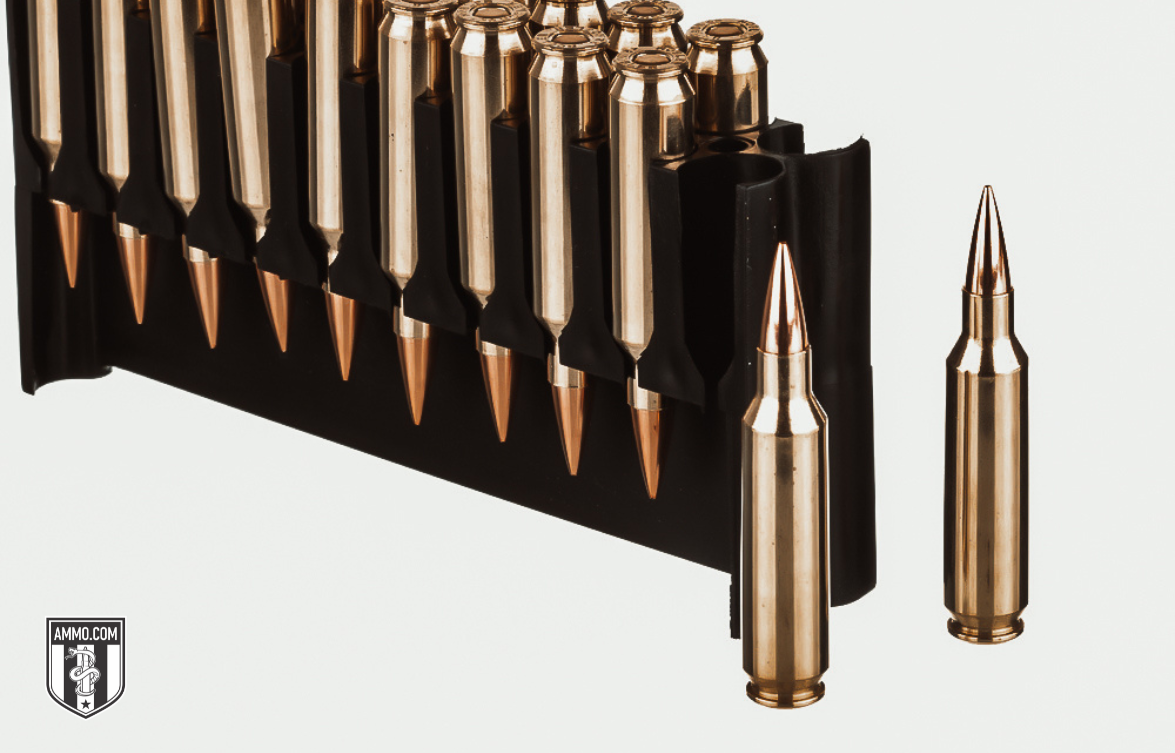22 ARC vs. 22 GT: The Latest Improvements to .22 Caliber Cartridges
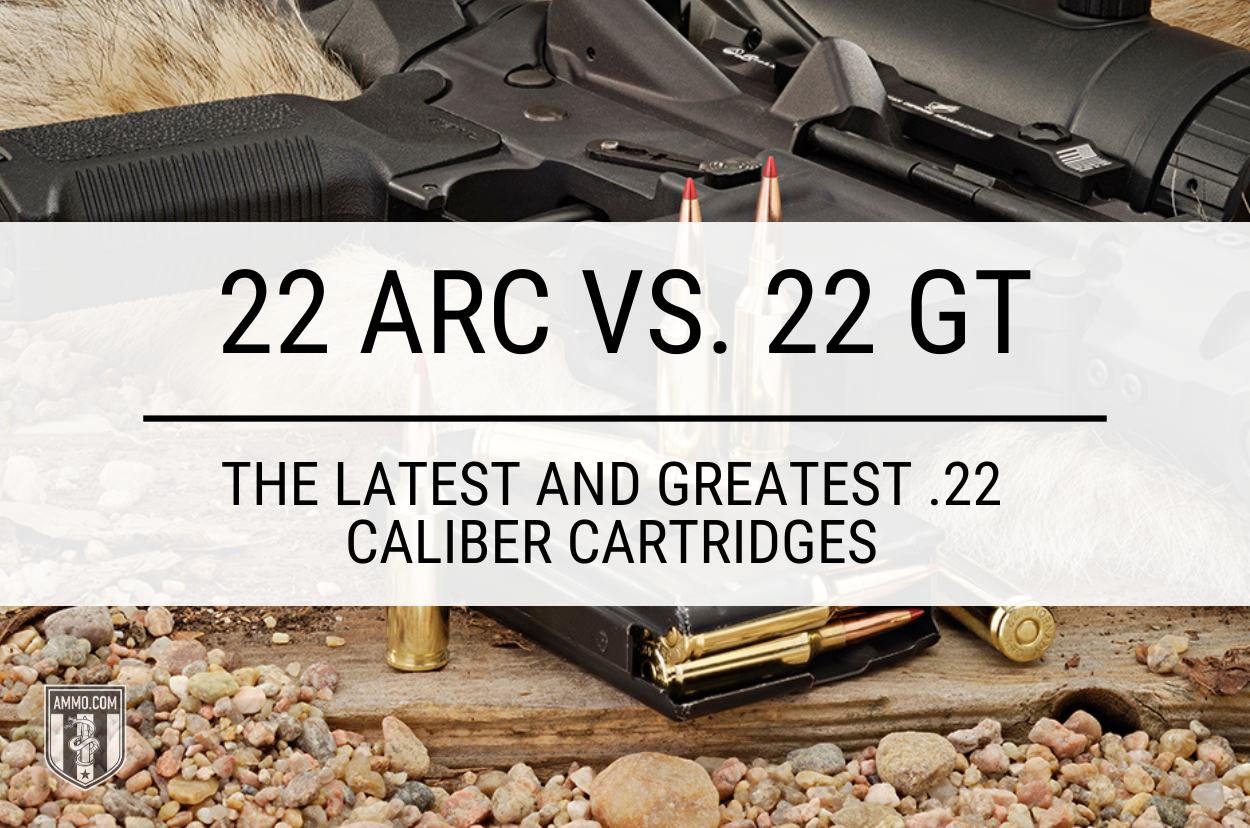
Two of the latest advancements in the .22 caliber are the 22 Advanced Rifle Cartridge (ARC) and 22 GT. Both high-velocity rifle cartridges are flat shooting, but which one is better for you?
In this 22 ARC vs. 22 GT comparison article, we’ll pit the rounds against one another in terms of real-world performance, including recoil, trajectory, and suitability for hunting and defense. By the end of it, you’ll have all the information you need to decide which cartridge is better for you.
Differences Between 22 ARC and 22 GT
The 22 GT and 22 ARC were created for similar purposes. It comes as no surprise that they are also similar in design. Let’s examine how their subtle differences bear on performance.
Cartridge Specifications
The 22 ARC is often mistakenly thought to be based on the 6mm ARC, but its parent case is actually the 6.5 Grendel. It utilizes a 0.224” diameter bullet and has a case with a neck diameter of 0.221”, base diameter of 0.441”, and length of 1.525”. The overall length is 2.260”, with a case capacity of 34.6 grains H2O and maximum pressure of 52,000 psi.
The 22 GT is based on the 6mm GT, and loosely modeled after the 308 Winchester (it shares the same base diameter). It also utilizes a 0.224” diameter bullet, has a case with a neck diameter of 0.249”, base diameter of 0.473”, and length of 1.724”. It is slightly longer than the 22 ARC, with an overall length of 2.320” to 2.563” (depending on the bullet and how it is seated). The 22 GT has a case capacity of 39.9 grains H2O and maximum pressure of 61,400 psi.
Now, let’s see how these specifications help determine the shooting performance of each cartridge.
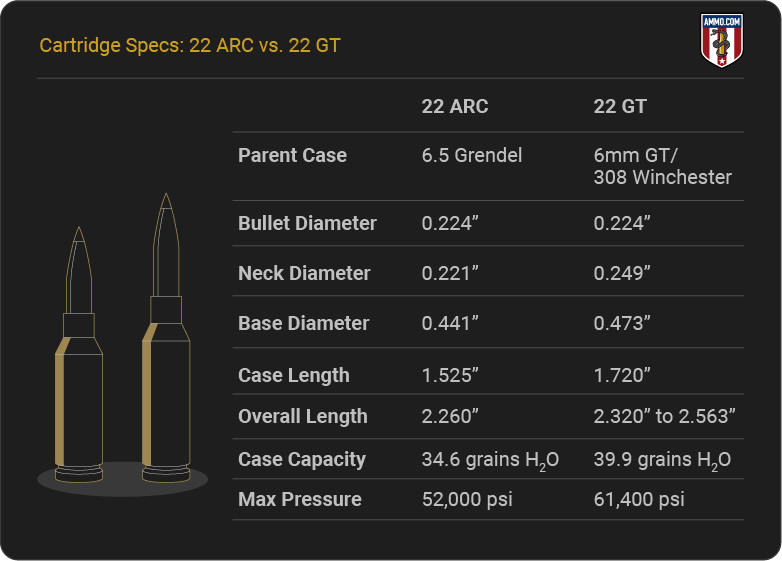
Recoil: 22 ARC vs. 22 GT
I always like to start by comparing recoil because it’s one of the first things a new shooter asks: “How hard does it kick?” A cartridge with more recoil moves the muzzle farther off the target with each shot, thus slowing accurate follow-up shots. Strong recoil can also cause the shooter to flinch, further worsening their marksmanship. Ultimately, the less recoil you experience, the more accurately you can fire.
Both rounds have virtually non-existent recoil, but we’ll dive deeper to give you a better idea for each. This comparison is based on free recoil energy, because it is objective (unlike “felt recoil”). It’s determined by four variables: projectile weight, propellant weight, muzzle velocity, and firearm weight.
When a 62 grain 22 ARC bullet is fired from an 8-pound rifle at 3,300 fps muzzle velocity, it generates about 2.5 ft-lbs of recoil energy.
When an 80 grain 22 GT bullet is fired from an 8-pound rifle at 3,364 fps muzzle velocity, it generates about 6 ft-lbs of recoil energy.
While neither cartridge is a shoulder thumper, the 22 ARC has less recoil. Most shooters will struggle to notice much difference.
The 22 ARC wins this section with a lower recoil.
Trajectory
A bullet’s trajectory is its path to the target. It is most often measured in inches of bullet drop, or minutes of angle (MOA). Although we often talk about "flat-shooting guns," a bullet’s trajectory is rarely a flat line. Instead, it frequently resembles an arch: rising, plateauing, and dropping.
When fired at targets within 100 yards, most rifle cartridges exhibit virtually zero bullet drop. As distance increases, bullet drop becomes more pronounced. This is partly because a bullet’s velocity steadily slows throughout its trajectory. A bullet requires more time to cover 100-200 yards than 0-100. As a result, gravity has more time to exert its influence on a bullet as it covers farther distances.
When a 22 ARC 62 grain ELD-VT bullet is sighted in at 200 yards, it will drop -5.6” at 300 yards, -16.4” at 400 yards, and -33.5” at 500 yards. The 22 ARC is a flat-shooting cartridge.
When a 22 GT 88 grain ELD-M bullet is sighted in at 200 yards, it will drop -7.2” at 300 yards, -21.6” at 400 yards, and -45.1” at 500 yards. The 22 GT has a flat trajectory, but not as flat as the 22 ARC’s.
The 22 ARC’s flatter trajectory wins this section.
Accuracy: 22 GT vs. 22 ARC
Accuracy is more often a function of the shooting platform and the shooter than of the cartridge. The ammo, rifle, shooting conditions, and shooter’s ability all affect a cartridge’s accuracy.
To keep things simple, we’ll only consider the cartridges' trajectories and recoil energy. Most shooters will find they are more accurate with the 22 ARC because it has less recoil and a flatter trajectory—two characteristics that rarely coincide.
The 22 ARC wins this section, but both cartridges are incredibly accurate in the hands of a capable shooter. That’s why they’re popular for PRS matches.
Ballistic Coefficient
A bullet’s ballistic coefficient (BC) is a numeric expression of how effectively it resists wind deflection and frontal air resistance. Put another way, it reflects how aerodynamic a bullet is. A higher BC is preferable for long-distance shooting, as it indicates the bullet will exhibit a more predictable trajectory.
Sleeker, heavier bullets have higher BCs than bulkier, lighter projectiles. The 22 ARC capitalizes on high-BC bullets. Its G1 BC ranges from 0.395 to 0.485, whereas the 22 GT G1 BC ranges from 0.308 to 0.312.
The 22 ARC wins this section, as it typically has higher-BC bullets.
Stopping Power: 22 ARC vs. 22 GT
“Stopping power” is a contested subject amongst shooters. Some believe in getting by with as little power as possible, claiming a well-placed shot is effective regardless of bullet size. Others adhere to the go-big-or-go-home mentality, claiming a more powerful round compensates for less-than-ideal shot placement (which happens more often than many shooters like to admit).
Let’s keep things simple by agreeing that stopping power is determined by penetration depth, wound column diameter, and kinetic energy transfer.
Both cartridges fire 0.224” diameter bullets in similar weights, so they will inflict similarly wide and deep wound columns. Kinetic energy transfer will, therefore, determine which round’s stopping power is better.
An 88 grain ELD-M 22 ARC bullet will have 1,212 ft-lbs of energy at 200 yards and 813 ft-lbs at 500.
An 88 grain ELD-M 22 GT bullet will have 1,671 ft-lbs of energy at 200 yards and 1,154 ft-lbs at 500 yards.
The 22 GT has more kinetic energy to transfer than the 22 ARC at any given range. It wins this section.
Hunting
Both cartridges can ethically harvest whitetail deer. However, some states prohibit .22 caliber bullets for deer hunting (check your local regulations before heading to the woods).
These .22 caliber cartridges excel at varmint hunting. While the 22-250 Remington was the gold standard for coyote hunting for decades, the 22 ARC and 22 GT now offer varmint hunters better ballistics.
The 22 GT offers coyote hunters more stopping power, but the 22 ARC provides a flatter trajectory. This section is a tie.
Defense: 22 GT vs. 22 ARC
I rarely recommend rifle cartridges for home defense because most of them are more likely to over-penetrate and endanger innocent bystanders than typical handgun cartridges such as 9mm, 40 S&W, and 45 ACP.
Some consider .22 caliber cartridges too anemic for self-defense. I don’t consider either of these rounds weak, though I still advise against implementing either for protection. Both are chambered in semi-auto (AR-15) rifles, so neither has an advantage with regard to firearms.
While both cartridges could stop a threat, I recommend using a firearm and cartridge better suited for home defense. This section is a tie.
Cost and Availability
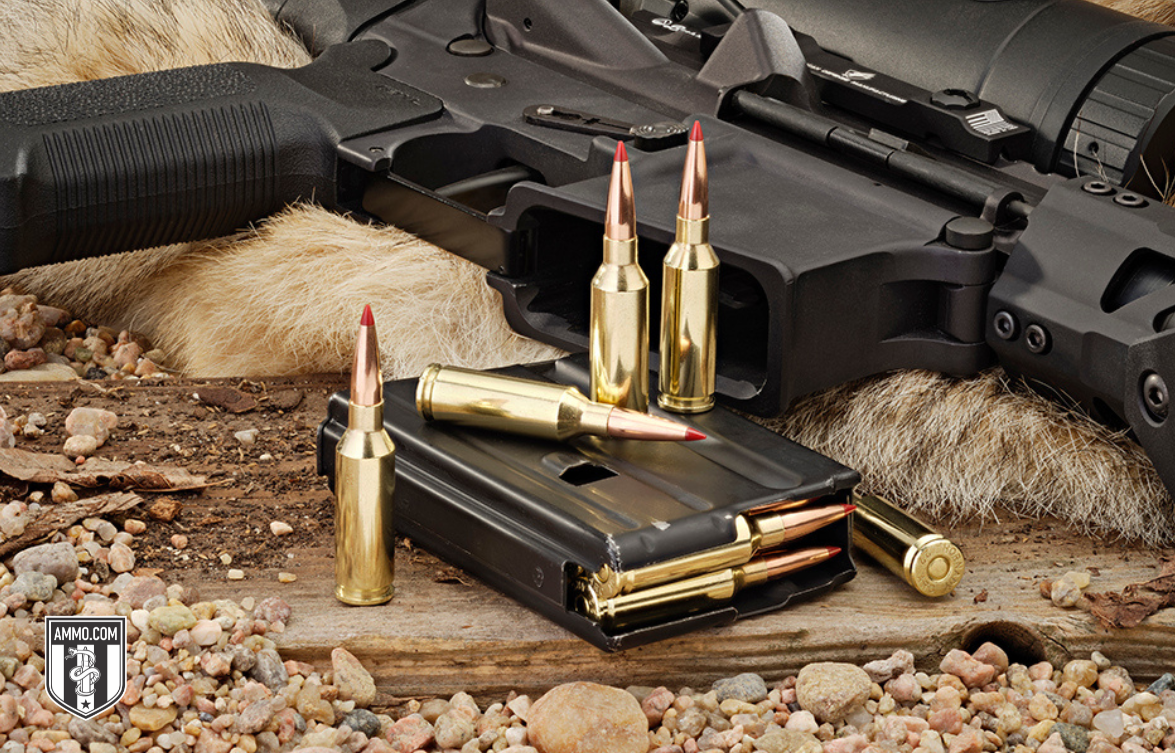
Ammo manufacturers do not produce 22 GT, so handloading is your only option for ammo, and you’re also limited to custom rifles.
Hornady is currently the only manufacturer of 22 ARC ammo. A few rifle manufacturers, like Ruger, have begun producing firearms chambered in 22 ARC.
At the time of writing, 22 ARC ammo is more abundant and slightly less costly. It wins this section.
Reloadability
Reloading is an excellent way to craft the perfect round for your firearm and save a little money on factory loads. The initial investment in supplies and equipment deters most from starting to handload. But once the upfront costs are behind you, you can create higher-quality ammo for low prices and enjoy total control over most of the process.
Both cartridges are reloadable (you must handload the 22 GT) with plenty of supplies, making this section a tie.
Ballistics
The team at Ammo.com has created ballistic charts for the 22 ARC and 223 Rem so you can quickly compare them.
22 ARC Ballistics
Administrative Note: The information below comes from the manufacturers. The actual ballistics obtained with your firearm can vary considerably from the advertised ballistics. Also, ballistics can vary from lot to lot with the same brand and type load. When manufacturer ballistic data were unavailable, ballistics were calculated using a ballistics calculator.
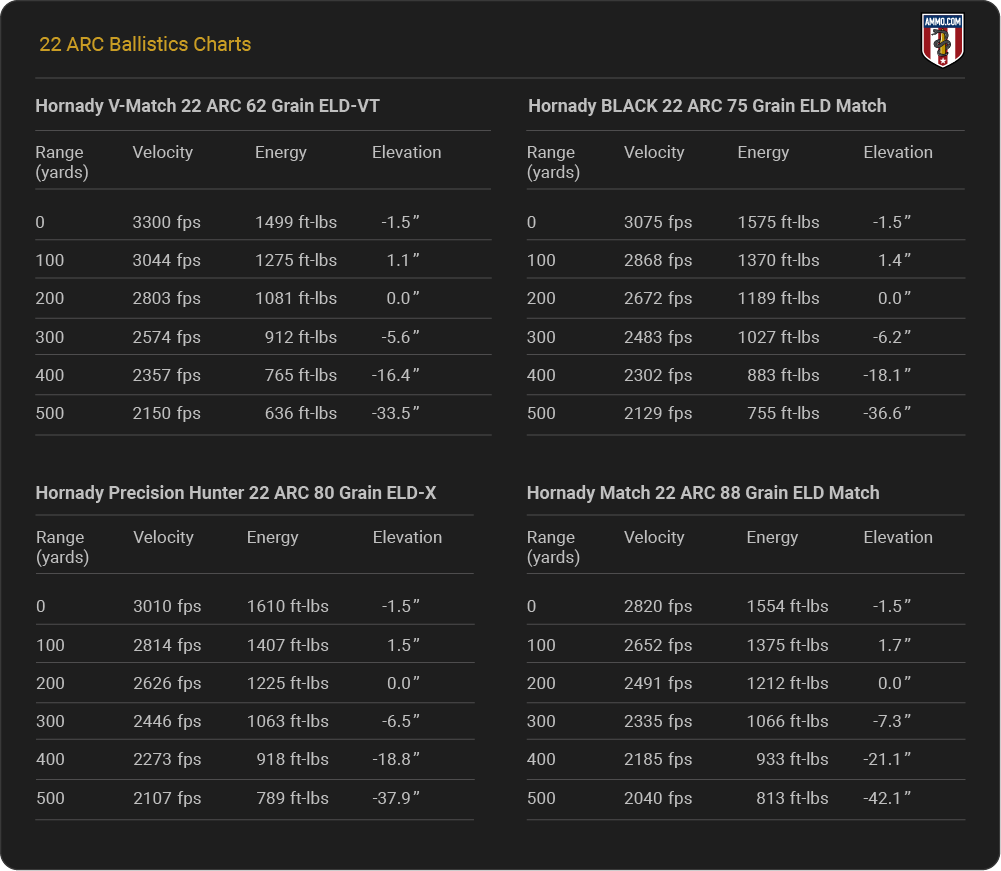
Take a deep dive into 22 ARC ballistics for factory ammo.
22 GT Ballistics
Administrative Note: The information below comes from the manufacturers. The actual ballistics obtained with your firearm can vary considerably from the advertised ballistics. Also, ballistics can vary from lot to lot with the same brand and type load. When manufacturer ballistic data were unavailable, ballistics were calculated using a ballistics calculator.
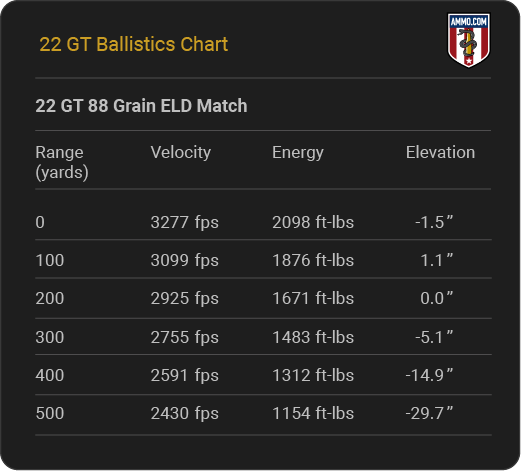
22 ARC Brief History
Hornady released the 22 Advanced Rifle Cartridge in 2024. It was designed to be accurate, fast, and have outstanding long-range capabilities for a .22 caliber round.
The verdict remains out as to whether the market will fully embrace this cartridge. Based on its ballistics alone, one might expect varmint hunters to trade in their .22-250 Remington rifles for 22 ARC. Of course, that would overlook how devoted most hunters are to their favorite rounds, as well as the difficulties of taking market share from an established cartridge.
22 GT Brief History
The 22 GT was developed for competition shooting in the early 2020s by George Gardner, owner of GA Precision, and Tom Jacobs, owner of Vapor Trail Bullets. It is a necked-down version of the 6mm GT.
The market has not yet embraced the 22 GT, although many shooters enjoy building 22 GT rifles and handloading ammo for matches and coyote hunting.
Parting Shots
Now that you’ve finished reading this 22 ARC vs. 22 GT comparison, you know that the 22 ARC won five sections (recoil, trajectory, accuracy, BC, and overall cost/availability). Three sections were a tie (hunting, defense, and reloadability). The 22 GT won one section (stopping power).
The 22 ARC easily wins this comparison, but the 22 GT is no slouch and should not be quickly overlooked. It offers some benefits the 22 ARC simply can’t match.
Be sure to grab your 22 ARC ammo at Ammo.com, where we have excellent customer service and fast shipping.
Frequently Asked Questions
The team at Ammo.com has gathered and answered some of the most commonly asked questions regarding 22 ARC vs. 22 GT.
How Does the 22 ARC Compare to the 22 GT in Terms of Accuracy and Velocity?
The 22 ARC is often more accurate than the 22 GT, but the 22 GT achieves higher velocities.
Which Is Better for Long-Range Shooting, 22 ARC or 22 GT?
The 22 ARC is better for long-range shooting because it has a flatter trajectory and high-BC bullets.
Ammo Comparisons
- .308 vs 5.56
- 6.5 Creedmoor vs .308
- .300 Blackout vs .308
- .300 Win Mag vs .308
- .243 vs .308
- .308 vs .30-06
- 7mm-08 vs .308
- .270 vs .308
- 7.62x39 vs .308
- .223 vs .308
- .338 Lapua vs .308
- .380 ACP vs 9mm
- .223 vs 5.56
- .300 Blackout vs 5.56
- 9mm vs 45 ACP
- 9mm vs 40 S&W
- .357 SIG vs 9mm
- 10mm vs 9mm
- 9mm vs 9mm Luger
- .243 vs .270
- .300 Win Mag vs .30-06
- .270 vs .30-06
- .40 vs .45
- 38 Special vs 357
- 9mm vs 40 vs 45
- 5.56 vs 7.62x39
- 338 Lapua vs .30-06
- .30-30 vs .30-06
- 300 PRC vs 338 Lapua
- .30-06 vs 7mm
- 300 Win Mag vs 338 Lapua
- 300 PRC vs 300 Win Mag
- 300 WSM vs 300 Win Mag
- 338 Win Mag vs 338 Lapua
- 12 Gauge vs 20 Gauge
- 10mm vs 357 Mag
- .30-30 vs 7.62x39
- 224 Valkyrie vs 22-250
- 17 HMR vs 22 Mag
- 7.62x39 vs .300 Blackout
- 45 ACP vs 45 Auto
- 45-70 vs 30-30
- 300 Blackout vs 223
- 357 Magnum vs 9mm
- 350 Legend vs 300 Blackout
- 224 Valkyrie vs 223
- 45 ACP vs 38 Super
- 6.5 Grendel vs .308
- 17 HMR vs 22 LR
- 10 Gauge vs 12 Gauge
- 22-250 vs 223
- 45 Colt vs 45 ACP
- 350 Legend vs 30-30
- 5.7x28 vs 223
- 5.7 vs 9mm
- 5.56 vs 5.7
- 22 vs 9mm
- Buckshot vs Birdshot
- 450 Bushmaster vs 308
- 450 Bushmaster vs 223
- Buckshot vs Slug
- 6.5 Grendel vs 5.56 vs 223
- 6mm ARC vs 6.5 Grendel
- 44 vs 45
- 458 SOCOM vs 5.56
- 357 vs 44
- 32 ACP vs 380
- 300 Win Mag vs 338 Win Mag vs 338 Lapua Mag
- 450 Bushmaster vs 458 SOCOM vs 50 Beowulf
- 6mm Creedmoor vs 6.5 Creedmoor
- TMJ vs FMJ
- 44 Special Vs 44 Magnum
- 45 90 vs 45 70
- 6.8 Western vs 6.8 SPC
- 50 Beowulf vs 50 BMG
- 26 Nosler vs 6.5 PRC
- 28 Gauge vs 410
- 6.8 SPC vs 5.56
- 6.8 SPC vs 6.5 Grendel
- 6.8 Western vs 7mm Rem Mag vs .28 Nosler
- 6.8 Western vs 6.5 Creedmoor
- 22 Hornet vs 223
- 6.8 Western vs 6.5 PRC
- .410 vs 12 Gauge
- .410 vs 20 Gauge
- 22 LR vs 22 Mag
- 6mm ARC vs 243
- 7mm-08 vs 270
- 243 vs 6.5 Creedmoor
- Nickel vs Brass Casing
- 204 Ruger vs 223
- 50 Beowulf vs 5.56
- 260 Remington vs 6.5 Creedmoor
- 6mm Remington vs 243
- 28 Nosler vs 300 PRC
- 50 Beowulf vs 50 AE
- 22 Nosler vs 22-250
- 450 Marlin vs 45-70
- 300 Win Mag vs 300 Norma
- 458 SOCOM vs 300 Blackout
- 38-55 vs 45-70
- 22 Hornet vs 22 LR
- 300 Norma vs 338 Lapua
- 338 Lapua vs 50 BMG
- 28 Nosler vs 300 Win Mag
- 28 Nosler vs 6.5 Creedmoor
- 204 vs 22-250
- 458 SOCOM vs 45 70
- 44 40 vs 45 70
- 6.8 SPC vs 6.5 Creedmoor
- 450 Bushmaster vs 30-06
- 7mm Rem Mag vs 300 Win Mag
- 30 Carbine vs 223
- 25-06 vs 30-06
- 26 Nosler vs 28 Nosler
- 16ga vs 12ga
- 30 06 vs 7.62 x54R
- 9mm Makarov vs 9mm Luger
- 350 Legend vs 223
- 30 Carbine vs 5.56
- 6.5x55 vs 6.5 Creedmoor
- 6.5 Creedmoor vs 270 vs 25-06
- M193 vs M855
- 450 Bushmaster vs 458 SOCOM
- 6.5 Grendel vs 6.5 Creedmoor
- 350 Legend vs 5.56
- .277 Fury vs 6.8 SPC
- 277 Fury vs 300 Win Mag
- 10mm vs .45 ACP
- 277 Fury vs 223
- 6.8 SPC vs 300 Blackout
- 6.5 PRC vs 6.5 Creedmoor
- 277 Fury vs 308
- 277 Fury vs 6.5 Creedmoor
- 350 Legend vs 450 Bushmaster
- 277 Fury Vs 5.56 NATO
- 10mm vs 40S&W
- 32 ACP vs 9mm
- 32 Special vs 9mm
- 8.6 Blackout vs 300 Blackout
- 30 Super Carry vs. 9mm
- 5.56 vs 9mm
- .50 Action Express vs 9mm
- 7.62x25 vs. 9mm
- 10mm vs 44 Magnum
- 300 Blackout vs 300 Win Mag
- 6.5 Grendel vs 300 Blackout
- 460 Rowland vs 10mm
- 300 RUM vs 300 PRC
- 300 Norma vs 300 PRC
- 45 GAP vs 45 ACP
- 7mm PRC vs 300 Win Mag
- 300 PRC vs 6.5 Creedmoor
- 300 PRC vs 308
- 357 SIG vs 357 Mag
- 7.62x39 vs 7.62x51
- 243 Win vs 223 Rem
- 30 Nosler vs 300 PRC
- 6.5 Creedmoor vs. 30-06 Springfield
- 450 S&W vs. 44 Magnum
- 6.5 Creedmoor vs. 300 Win Mag
- 454 Cassull vs. 45-70 Govt
- 454 Cassull vs. 44 Mag
- 7.62x54r vs. 308 Winchester
- 22 ARC vs. 223 Rem
- Subsonic vs. Supersonic Ammo
